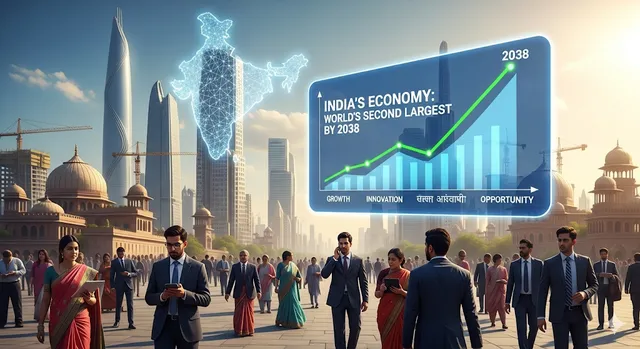- By Shreyansh Mangla
- Thu, 28 Aug 2025 06:15 PM (IST)
- Source:JND
EY's Economy Watch Report based on IMF projections, has stated that India is projected to become the world's second-largest economy by 2038 based on Purchasing Power Parity (PPP).
The report titled 'Where India stands in the group of five largest economies' was posted on Wednesday, August 27, 2025. It suggests that India's GDP could expand to USD 20.7 trillion by 2030, in terms of PPP, potentially surpassing the economies of the United States, Germany, and Japan, while remaining behind China.
Factors Driving India's Economic Growth
The EY report identifies several key factors that contribute to India's projected economic acceleration:
Demographics: India's significant advantage is its young population, with a median age of 28.8 years in 2025. This large workforce has the potential to boost GDP growth in a relatively short period.
High Savings: A high savings rate combined with significant investments can help offset the effects of government debt.
Prudent Fiscal Path: The report notes that India's government debt, which currently stands at 81.3 per cent of GDP, is projected to decrease to 75.8 per cent by 2030. This indicates a balanced fiscal approach for long-term stability.
ALSO READ: Anlon Healthcare IPO Day 2: Check Subscription Status, GMP, Expected Allotment And Listing Dates
India's Advantage Over Other Major Economies
The report highlights that India's favorable demographics and fiscal management give it an edge over other major economies. In contrast, several developed nations face constraints:
China: While China is expected to remain the largest economy at USD 42.2 trillion by 2030 in terms of PPP, it faces challenges from a rapidly aging population and significant debt.
United States: The US struggles with high debt levels, which can slow down economic growth.
Germany and Japan: These advanced economies are constrained by their heavy reliance on global trade and an aging population, which shrinks the available workforce and increases pension costs.
Reforms and Future Projections
The EY report also points to several reformative steps taken by the Indian government to boost the country's GDP. These include:
Low Inflation: The government has maintained a stable economic environment with low inflation.
Sustainable Fiscal Policy and Manageable Debt: Consistent fiscal policies are being implemented to ensure long-term economic health.
Innovation: The government is focusing on innovation in sectors like artificial intelligence (AI) and semiconductors.
Foundational Drivers: Significant investments in infrastructure, a talented workforce, and supportive government policies are foundational to this growth.
These initiatives are expected to help India's economy surpass even Germany's GDP in terms of market exchange terms by as early as 2028.
Long-Term Vision
India's economic trajectory aligns with the government's "Viksit Bharat 2047" vision. This initiative aims to transform India into a self-reliant, developed nation by the 100th anniversary of its independence in 2047. The EY report suggests that achieving this long-term goal will depend on India's continued demographic strength, fiscal consistency, and an innovation-led approach to growth.
The report, authored by EY's Chief Policy Advisor, D K Srivastava, concludes that India's self-sustaining nature, particularly its high domestic demand, positions it strongly to overcome global challenges. The projection that India could surpass the US economy by 2038 is contingent on the nation's continued growth trajectory.

